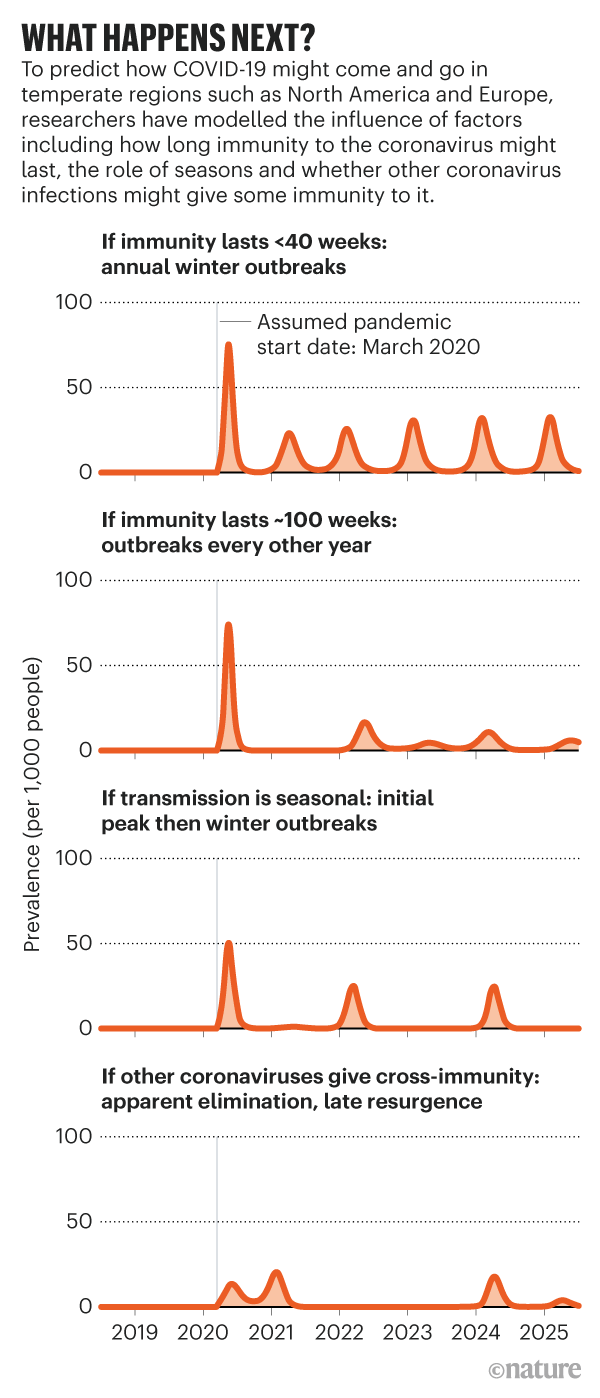Click to join the conversation with over 500,000 Pentecostal believers and scholars
Click to get our FREE MOBILE APP and stay connected
| PentecostalTheology.com



June 2021. The world has been in pandemic mode for a year and a half. The virus continues to spread at a slow burn; intermittent lockdowns are the new normal. An approved vaccine offers six months of protection, but international deal-making has slowed its distribution. An estimated 250 million people have been infected worldwide, and 1.75 million are dead.
Scenarios such as this one imagine how the COVID-19 pandemic might play out1. Around the world, epidemiologists are constructing short- and long-term projections as a way to prepare for, and potentially mitigate, the spread and impact of SARS-CoV-2, the virus that causes COVID-19. Although their forecasts and timelines vary, modellers agree on two things: COVID-19 is here to stay, and the future depends on a lot of unknowns, including whether people develop lasting immunity to the virus, whether seasonality affects its spread, and — perhaps most importantly — the choices made by governments and individuals. “A lot of places are unlocking, and a lot of places aren’t. We don’t really yet know what’s going to happen,” says Rosalind Eggo, an infectious-disease modeller at the London School of Hygiene & Tropical Medicine (LSHTM).
“The future will very much depend on how much social mixing resumes, and what kind of prevention we do,” says Joseph Wu, a disease modeller at the University of Hong Kong. Recent models and evidence from successful lockdowns suggest that behavioural changes can reduce the spread of COVID-19 if most, but not necessarily all, people comply.
Last week, the number of confirmed COVID-19 infections passed 15 million globally, with around 650,000 deaths. Lockdowns are easing in many countries, leading some people to assume that the pandemic is ending, says Yonatan Grad, an epidemiologist at the Harvard T. H. Chan School of Public Health in Boston, Massachusetts. “But that’s not the case. We’re in for a long haul.”
If immunity to the virus lasts less than a year, for example, similar to other human coronaviruses in circulation, there could be annual surges in COVID-19 infections through to 2025 and beyond. Here, Nature explores what the science says about the months and years to come.
What happens in the near future?
The pandemic is not playing out in the same way from place to place. Countries such as China, New Zealand and Rwanda have reached a low level of cases — after lockdowns of varying lengths — and are easing restrictions while watching for flare-ups. Elsewhere, such as in the United States and Brazil, cases are rising fast after governments lifted lockdowns quickly or never activated them nationwide.
The latter group has modellers very worried. In South Africa, which now ranks fifth in the world for total COVID-19 cases, a consortium of modellers estimates2 that the country can expect a peak in August or September, with around one million active cases, and cumulatively as many as 13 million symptomatic cases by early November. In terms of hospital resources, “we’re already breaching capacity in some areas, so I think our best-case scenario is not a good one”, says Juliet Pulliam, director of the South African Centre for Epidemiological Modelling and Analysis at Stellenbosch University.
Cinemagoers in Hangzhou, China, follow new norms of distancing and mask-wearing.Credit: AFP/Getty
But there is hopeful news as lockdowns ease. Early evidence suggests that personal behavioural changes, such as hand-washing and wearing masks, are persisting beyond strict lockdown, helping to stem the tide of infections. In a June report3, a team at the MRC Centre for Global Infectious Disease Analysis at Imperial College London found that among 53 countries beginning to open up, there hasn’t been as large a surge in infections as predicted on the basis of earlier data. “It’s undervalued how much people’s behaviour has changed in terms of masks, hand washing and social distancing. It’s nothing like it used to be,” says Samir Bhatt, an infectious-disease epidemiologist at Imperial College London and a co-author of the study.
Researchers in virus hotspots have been studying just how helpful these behaviours are. At Anhembi Morumbi University in São Paulo, Brazil, computational biologist Osmar Pinto Neto and colleagues ran more than 250,000 mathematical models of social-distancing strategies described as constant, intermittent or ‘stepping-down’ — with restrictions reduced in stages — alongside behavioural interventions such as mask-wearing and hand washing.
The team concluded that if 50–65% of people are cautious in public, then stepping down social-distancing measures every 80 days could help to prevent further infection peaks over the next two years4. “We’re going to need to change the culture of how we interact with other people,” says Neto. Overall, it’s good news that even without testing or a vaccine, behaviours can make a significant difference in disease transmission, he adds.
Infectious-disease modeller Jorge Velasco-Hernández at the National Autonomous University of Mexico in Juriquilla and colleagues also examined the trade-off between lockdowns and personal protection. They found that if 70% of Mexico’s population committed to personal measures such as hand washing and mask-wearing following voluntary lockdowns that began in late March, then the country’s outbreak would decline after peaking in late May or early June5. However, the government lifted lockdown measures on 1 June and, rather than falling, the high number of weekly COVID-19 deaths plateaued. Velasco-Hernández’s team thinks that two public holidays acted as superspreading events, causing high infection rates right before the government lifted restrictions6.
Social distancing could be required intermittently for years to suppress COVID-19 peaks.Credit: John Edelson/AFP/Getty
In regions where COVID-19 seems to be on the decline, researchers say that the best approach is careful surveillance by testing and isolating new cases and tracing their contacts. This is the situation in Hong Kong, for instance. “We are experimenting, making observations and adjusting slowly,” says Wu. He expects that the strategy will prevent a huge resurgence of infections — unless increased air traffic brings a substantial number of imported cases.
But exactly how much contact tracing and isolation is required to contain an outbreak effectively? An analysis7 by the Centre for the Mathematical Modelling of Infectious Diseases COVID-19 Working Group at the LSHTM simulated fresh outbreaks of varying contagiousness, starting from 5, 20 or 40 introduced cases. The team concluded that contact tracing must be rapid and extensive — tracing 80% of contacts within a few days — to control an outbreak. The group is now assessing the effectiveness of digital contact tracing and how long it’s feasible to keep exposed individuals in quarantine, says co-author Eggo. “Finding the balance between what actually is a strategy that people will tolerate, and what strategy will contain an outbreak, is really important.”
Tracing 80% of contacts could be near-impossible to achieve in regions still grappling with thousands of new infections a week — and worse, even the highest case counts are likely to be an underestimate. A June preprint1 from a Massachusetts Institute of Technology (MIT) team in Cambridge analysing COVID-19 testing data from 84 countries suggests that global infections were 12 times higher and deaths 50% higher than officially reported (see ‘Predicting cases and deaths’). “There are many more cases out there than the data indicate. As a consequence, there’s higher risk of infection than people may believe there to be,” says John Sterman, co-author of the study and director of the MIT System Dynamics Group.
Source: Data from ref. 1, updated with authors’ estimates until 10 July 2020
For now, mitigation efforts, such as social distancing, need to continue for as long as possible to avert a second major outbreak, says Bhatt. “That is, until the winter months, where things get a bit more dangerous again.”
What will happen when it gets cold?
It is clear now that summer does not uniformly stop the virus, but warm weather might make it easier to contain in temperate regions. In areas that will get colder in the second half of 2020, experts think there is likely to be an increase in transmission.
Many human respiratory viruses — influenza, other human coronaviruses and respiratory syncytial virus (RSV) — follow seasonal oscillations that lead to winter outbreaks, so it is likely that SARS-CoV-2 will follow suit. “I expect SARS-CoV-2 infection rate, and also potentially disease outcome, to be worse in the winter,” says Akiko Iwasaki, an immunobiologist at the Yale School of Medicine in New Haven, Connecticut. Evidence suggests that dry winter air improves the stability and transmission of respiratory viruses8, and respiratory-tract immune defence might be impaired by inhaling dry air, she adds.
In addition, in colder weather people are more likely to stay indoors, where virus transmission through droplets is a bigger risk, says Richard Neher, a computational biologist at the University of Basel in Switzerland. Simulations by Neher’s group show that seasonal variation is likely to affect the virus’s spread and might make containment in the Northern Hemisphere this winter more difficult9.
In future, SARS-CoV-2 outbreaks could arrive in waves every winter. The risk to adults who have already had COVID-19 could be reduced, as with flu, but it would depend on how rapidly immunity to this coronavirus wears off, says Neher. What’s more, the combination of COVID-19, flu and RSV in autumn and winter could be challenging, says Velasco-Hernández, who is setting up a model of how such viruses might interact.
It remains unknown whether infection with other human coronaviruses can offer any protection against SARS-CoV-2. In a cell-culture experiment involving SARS-CoV-2 and the closely related SARS-CoV, antibodies from one coronavirus could bind to the other coronavirus, but did not disable or neutralize it10.
To end the pandemic, the virus must either be eliminated worldwide — which most scientists agree is near-impossible because of how widespread it has become — or people must build up sufficient immunity through infections or a vaccine. It is estimated that 55–80% of a population must be immune for this to happen, depending on the country11.
Unfortunately, early surveys suggest there is a long way to go. Estimates from antibody testing — which reveals whether someone has been exposed to the virus and made antibodies against it — indicate that only a small proportion of people have been infected, and disease modelling backs this up. A study of 11 European countries calculated an infection rate of 3–4% up to 4 May12, inferred from data on the ratio of infections to deaths, and how many deaths there had been. In the United States, where there have been more than 150,000 COVID-19 deaths, a survey of thousands of serum samples, coordinated by the US Centers for Disease Control and Prevention, found that antibody prevalence ranged from 1% to 6.9%, depending on the location13.
What happens in 2021 and beyond?
The pandemic’s course next year will depend greatly on the arrival of a vaccine, and on how long the immune system stays protective after vaccination or recovery from infection. Many vaccines provide protection for decades — such as those against measles or polio — whereas others, including whooping cough and influenza, wear off over time. Likewise, some viral infections prompt lasting immunity, others a more transient response. “The total incidence of SARS-CoV-2 through 2025 will depend crucially on this duration of immunity,” wrote Grad, Harvard epidemiologist Marc Lipsitch and colleagues in a May paper14 exploring possible scenarios (see ‘What happens next?’).
Source: Ref. 14
Researchers know little so far about how long SARS-CoV-2 immunity lasts. One study15 of recovering patients found that neutralizing antibodies persisted for up to 40 days after the start of infection; several other studies suggest that antibody levels dwindle after weeks or months. If COVID-19 follows a similar pattern to SARS, antibodies could persist at a high level for 5 months, with a slow decline over 2–3 years16. Still, antibody production is not the only form of immune protection; memory B and T cells also defend against future encounters with the virus, and little is known so far about their role in SARS-CoV-2 infection. For a clear answer on immunity, researchers will need to follow a large number of people over a long time, says Michael Osterholm, director of the Center for Infectious Disease Research and Policy (CIDRAP) at the University of Minnesota, Minneapolis. “We’re just going to have to wait.”
If infections continue to rise rapidly without a vaccine or lasting immunity, “we will see regular, extensive circulation of the virus”, says Grad. In that case, the virus would become endemic, says Pulliam. “That would be really painful.” And it is not unimaginable: malaria, a preventable and treatable disease, kills more than 400,000 people each year. “These worst-case scenarios are happening in many countries with preventable diseases, causing huge losses of life already,” says Bhatt.
If the virus induces short-term immunity — similar to two other human coronaviruses, OC43 and HKU1, for which immunity lasts about 40 weeks — then people can become reinfected and there could be annual outbreaks, the Harvard team suggests. A complementary CIDRAP report17, based on trends from eight global influenza pandemics, points to significant COVID-19 activity for at least the next 18–24 months, either in a series of gradually diminishing peaks and valleys, or as a “slow burn” of continuing transmission without a clear wave pattern. Yet these scenarios remain only guesses, because this pandemic has so far not followed the pattern of pandemic flu, says Osterholm. “We’re in a coronavirus pandemic for which we have no precedents.”
Another possibility is that immunity to SARS-CoV-2 is permanent. In that case, even without a vaccine, it is possible that after a world-sweeping outbreak, the virus could burn itself out and disappear by 2021. However, if immunity is moderate, lasting about two years, then it might seem as if the virus has disappeared, but it could surge back as late as 2024, the Harvard team found.
That forecast, however, does not take the development of effective vaccines into account. It’s unlikely that there will never be a vaccine, given the sheer amount of effort and money pouring into the field and the fact that some candidates are already being tested in humans, says Velasco-Hernández. The World Health Organization lists 26 COVID-19 vaccines currently in human trials, with 12 of them in phase II trials and six in phase III. Even a vaccine providing incomplete protection would help by reducing the severity of the disease and preventing hospitalization, says Wu. Still, it will take months to make and distribute a successful vaccine.
The world will not be affected equally by COVID-19. Regions with older populations could see disproportionally more cases in later stages of the epidemic, says Eggo; a mathematical model from her team, published in June18 and based on data from six countries, suggests that the susceptibility to infection in children and people under 20 years old is approximately half that of older adults.
There is one thing that every country, city and community touched by the pandemic has in common. “There is so much we still don’t know about this virus,” says Pulliam. “Until we have better data, we’re just going to have a lot of uncertainty.”








Most Talked About Today